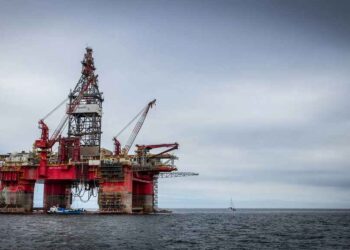The Keystone Pipeline is a new export pipeline project instigated by TransCanada and ConocoPhillips. When the $12bn pipeline is complete it will traverse a distance of 3,461km (2,151 miles) and transport oil sands crude oil from Hardisty in Alberta to the US Midwest markets at Wood River and Patoka, Illinois, and via a branch of the pipeline to Cushing, Oklahoma, US.
The Canadian section of the project was completed in June 2010. It involved the conversion of about 864km (537 miles) of existing Canadian Mainline pipeline facilities from natural gas to crude oil transmission service and also the construction of 373km (232 miles) of a 30in pipeline, 16 pump stations and terminal facilities to Hardisty, Alberta. The section marks the completion of phase I of the Keystone Pipeline.
The US section of the project under phase I included the construction of about 1,744km (1,084 miles) of a 30in pipeline, 23 pump and transmission stations and delivery facilities at Wood River and Patoka Illinois.
Phase I of the Keystone Pipeline has an initial nominal capacity of 435,000 barrels per day.
Construction of phase II began in 2010 and includes an extension of the pipeline by 480km (298 mile) from Steele City, Nebraska, to Cushing, Oklahoma. 11 new pump stations will be constructed, which will boost pipeline capacity to 591,000bpd.
“Phase I of the Keystone Pipeline has an initial nominal capacity of 435,000bpd.”
The second phase is scheduled for completion by the first quarter of 2011.
Keystone has contracts with oil sands producers totalling 495,000 barrels per day with an average contract term of 18 years.
ConocoPhillips will use the Keystone Pipeline to deliver raw materials for a production and processing partnership with EnCana to pump raw oil sands bitumen out of Alberta for upgrading and refining in Illinois and Texas.
TransCanada hopes to secure oil shipping contracts that will prompt construction of a second, longer leg to take 750,000 barrels daily to Texas refineries clustered east of Houston, around Port Arthur.
Keystone Pipeline construction
TransCanada proposed the Keystone Pipeline project on 9 February 2005 and began the process of setting it up. On 22 January 2008 ConocoPhillips acquired a 50% stake in the project.
Construction began on the pipeline on 28 May 2008, but the processes leading up to this have been dogged by environmental protests. On 21 September 2007 the National Energy Board of Canada approved the construction of the Canadian section of the pipeline, including the conversion of a section of the Canadian Mainline gas pipeline to crude oil pipeline.
Following this, on 17 March 2008 the US Department of State issued a Presidential Permit authorising the construction, maintenance and operation of facilities at the US and Canada border. Construction broke ground at Hardisty, an oil pipeline and storage hub about 100km north-east of Calgary.
In the stretch to Illinois the new pipeline will be 30in in diameter and 36in from the Nebraska / Kansas border to Cushing, Oklahoma. It will be buried with a minimum depth of cover of 4ft (1.2m). The operating pressure of the new pipeline sections will be 1,440psi (9,930kPa) and the existing pipeline proposed for conversion to crude oil transportation will operate at its approved operating pressure of 880psig (6,067kPa).
Design and contractors
In 2007 the detailed design, plans and material procurement were completed and final permits were obtained.
“Construction broke ground at Hardisty, an oil pipeline and storage hub.”
The contractor for the Canadian construction is Ledcor Pipeline along with Pioneer Truck Lines (pipe offloading and stockpiling). The Canadian conversion section of the project was carried out by Louisbourg Pipelines, Whaler Industrial Contracting (Pump Stations – Group 2 [Saskatchewan]), Lockerbie & Hole Eastern (Pump Stations – Groups 3 and 4 [Saskatchewan and Manitoba]), NUSCO Northern (Storage Tanks [Hardisty Terminal, Alberta]).
The US section of the project is divided into spreads and has been carried out by a number of contractors: Henkels & McCoy Inc (spread 1), Michels Corporation (spread 2 and 3), Mid West Constructors a consortium of HC Price, Gregory & Cook and Sheehan (spread 4 to 11), TG Mercer (pipe offloading and stockpiling), The Industrial Company Wyoming (Pump Stations – Groups 1 and 2 [North Dakota and South Dakota]) and Jones-Blythe Construction (Pump Stations – Group 5 [Missouri and Illinois]).
Keystone Gulf Coast Expansion project
Plans to extend the Keystone pipeline from Western Canada to the US Gulf coast were announced in July 2008 and was approved in March 2010.
The expansion project will involve the construction of a 2,673km (1,661 miles), 36in pipeline. It will provide an additional capacity of 500,000bpd. Beginning at Hardisty, Alberta, the pipeline will run southeast through Saskatchewan, Montana, South Dakota and Nebraska. It will include the section of the keystone pipeline that will cover Kansas to Cushing, Oklahoma. It will then extend from Oklahoma and Texas to the terminals on the Gulf Coast.
On completion the project will increase the total capacity of the Keystone pipeline to 1.1 million bpd. Construction of the project will begin in the first quarter of 2011.

















































